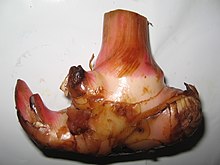Ginger family
| Ginger family | ||||||||||||
|---|---|---|---|---|---|---|---|---|---|---|---|---|

Inflorescences of Hedychium longicornutum |
||||||||||||
| Systematics | ||||||||||||
|
||||||||||||
| Scientific name | ||||||||||||
| Zingiberaceae | ||||||||||||
| Martinov |
The ginger plants (Zingiberaceae) are a family of the order of the ginger-like (Zingiberales) within the monocotyledons ( monocotyledons ). Depending on the source, this family contains 52 or 53 genera and is the most species-rich family of the Zingiberales with 1200 or more than 1300 species. Some species are used by humans as aromatic and medicinal plants , for example ginger , turmeric and citrus root . Many species are tropical ornamental plants .
Description and ecology


illustration from Koehler 1887.

Appearance and leaves
They are evergreen, perennial herbaceous plants . They form fleshy rhizomes that can be bulbous and thickened; in many species they form roots. They grow mostly terrestrial, rarely epiphytic . Only short stems are formed, which in many species are replaced by false stems , which are formed by the leaf sheaths of the leaves.
The alternate and two-line (distich) arranged leaves are never united to form basal rosettes. The position of the leaves also distinguishes the two families Costaceae and Zingiberaceae. The stalked to sessile leaves have a simple leaf sheath. The undivided leaf blades are herbaceous to leathery, with or without hair. In the budding stage, the leaf blade is rolled up lengthways. There is a raised midrib and parallel veins. The leaf margin is smooth. There are mostly ligules present. The lowest leaves are often greatly reduced, so that only the leaf sheath is formed.
Inflorescences and flowers
The inflorescences are formed terminally on the false stems or on their own short stems covered by leaf sheaths that emerge directly from the rhizomes . The inflorescences are dickkopfige to narrow spiked thyrsi , or they are of two to siebenblütigen cymes composite traubige inflorescences. The inflorescences often contain flashy, brightly colored bracts (bracts) and few to many flowers.

The hermaphrodite flowers are threefold and zygomorphic . The perianth is double. The three sepals are fused into a relatively narrow tube that is open on one side, sometimes spathaähnlich acts or above tridentate or -lappig. The three petals are fused together at their base; the three corolla lobes differ greatly in length and shape, depending on the taxon. There are two circles with originally three stamens each. Only the middle stamen of the inner circle is fertile ; it has a long or short stamen . All other stamens are reduced to staminodes and at least one or three are missing. The two lateral staminodes of the outer circle are similar to the corolla or form narrow teeth at the base of the labellum, with which they can be fused or they are missing. The middle staminodium of the outer circle is always missing. The two lateral staminodes of the inner circle have grown together to form a so-called labellum ; it represents the most conspicuous part of the flower. Three carpels have become an under constant (syncarp) ovary grown, which may be mono- or dreikammerig, with more or less many ovules per ovary chamber. The very thin stylus is located in a furrow in the filament and the stigma is above the anthers .
The flowers secrete a relatively large amount of nectar from two nectaries located at the base of the ovary. The individual flowers wither quickly, usually they are open for less than a day. The pollination is done by insects ( Entomophilie ) or birds ( ornithophily ).
Fruits and seeds
They form dry to fleshy capsule fruits to sometimes berry-like fruits that contain few to many seeds. The seeds contain starch. The straight embryo has a germ layer ( cotyledons ). The seeds have an aril , which is often lobed to fringed.
Ingredients and chromosome number
All species have excretory cells in their base tissue that contain essential or essential oils . It is silica in small spherical or disk-shaped bodies in lining cells or as siliceous sand in parenchymal cells accumulated . The number of chromosomes is usually n = 12 (9–26).
Systematics and distribution



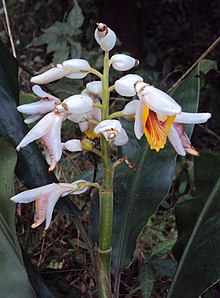


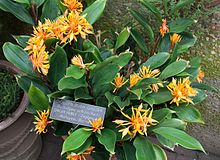

The mostly tropical species are mostly native to the Paleotropic and are mainly found in Southeast Asia and the Indonesian archipelago. Only from the genus Renealmia are species found in the Neotropic . Four genera occur in Africa: Aframomum , Aulotandra , Siphonochilus and Renealmia .
The family name Zingiberaceae was in 1820 by Iwan Iwanowitsch Martynow in Tekhno-Botanicheskīĭ Slovar ': na latinskom i rossīĭskom iazykakh. Sanktpeterburgie , p. 682 and published by John Lindley in Key Bot. , 69, September 1835 . The type genus is Zingiber Boehm. The generic name Zingiber is derived from a Sanskrit word sringavera and means horn-shaped, this refers to the rhizomes. Synonyms for Zingiberaceae Mart. are Alpiniaceae Link , Amomaceae J.St.-Hil. , nom. illeg., Curcumaceae Dumort. In the past, the taxa of today's Costaceae family also belonged to the Zingiberaceae family, but they are well defined by the lack of essential oils and the position of the leaves.
Subfamilies with tribe and genera
The ginger family (Zingiberaceae) is divided into four subfamilies and six tribe with about 52 to 53 genera and 1200 to more than 1300 species. In the largely Kress et al. In 2002 some genera are polyphyletic , for example Afromonum , Alpinia , Globba , Curcuma and Zingiber . This was followed by many new descriptions and changes in the scope of genres, which are documented with the respective literature:
- Subfamily Zingiberoideae Hasskarl : Distribution in the Indonesian archipelago and in tropical Australia. It contains two tribes:
- Tribe Globbeae: It contains three (to four) genera:
- Gagnepainia K.Schum. : The only three species are distributed from Thailand to Cambodia and southern Vietnam .
- Globba L. (Syn .: Hura J.Koenig , Lampujang J.Koenig , Sphaerocarpos J.F.Gmel. , Manitia Giseke , Mantisia Sims , Ceratanthera Hornem. , Ceratanthera T.Lestib. , Colebrookia Donn ex T.Lestib. , Achilus Hemsl. ) : The approximately 100 species arewidespreadfrom the eastern tropical Himalayas to southern China, India and from Indochina to Malaysia and northeastern Australia. Most of the species arenative tothe Indochinese monsoon region . The fourformer Mantisia speciesnativeto India , Bangladesh , Myanmar and the Malay Archipelago form the Mantisia Sims sectionwithin the genus Globba .
- Hemiorchis in short : The three to four species are distributed from the central and eastern Himalayas to Myanmar .
- Tribe Zingibereae (including the genera of the Hedychieae): It contains 20 to 24 genera:
- Boesenbergia Kuntze (Syn .: Gastrochilus Wall. Nom. Illeg., Banglium Buch.-Ham. Ex Wall. Nom. Nud., Curcumorpha A.S.Rao & DMVerma ): The approximately 60 species are in tropical to subtropical Asia, especially in the southern tropical Himalayan region and all of Southeast Asia widespread; with centers of biodiversity in the Indochinese monsoon area and on Borneo .
- Camptandra Ridl. : The fouror sospecies occur on the Malay Peninsula and Borneo .
- Cautleya Hook. f. : The only two species are widespread in the Himalaya region from northern India, Nepal, Bhutan, Myanmar and Thailand to southern China to Vietnam.
- Cornukaempferia Mood & K.Larsen : The three species that have been found in Thailand since 2007.
- Curcuma L. (Syn .: Erndlia Giseke , Kua Rheede ex Medic. , Hitcheniopsis (Baker) Ridl. , Paracautleya R.M.Sm. , Stissera Giseke nom. Illeg.): The (50 to) about 90 species are in tropical to subtropical Asia andwidespreadin Australasia from India to Queensland .
- Distichochlamys M.F.Newman : The four species since 2012 are only found in Vietnam.
- Haniffia Holttum : The three species since 2007 occur from the Malay Peninsula to southern Thailand .
- Haplochorema K. Schum. : Of the five species since 2006, four occur only on Borneo and one only on Sumatra .
- Hedychium J.Koenig (Syn .: Brachychilum (R.Br. ex Wall.) Petersen , Gamochilus T.Lestib. , Gandasulium Rumph. Ex Kuntze ): The approximately 88 species since 2011 arewidespreadfrom southern Asia to Southeast Asia and are also emerging Madagascar before.
-
Hitchenia Wall. : It contains only one type:
- Hitchenia glauca Wall. : It occurs in Myanmar.
-
Kaempferia L. (Syn .: Monolophus Wall. , Tritophus T.Lestib. ): The 40 or so species are widespread in tropical to subtropical Asia; for example:
- Indian spice lily ( Kaempferia galanga L. )
-
Laosanthus K.Larsen & Jenjitt. : It contains only one type:
- Laosanthus graminifolius K.Larsen & Jenjitt. : Only specimens from Laos are deposited in herbaria.
- Larsenianthus W.J. Kress & Mood : The four species are distributed from northeast India through northeast Bangladesh to northern Myanmar.
-
Nanochilus K. Schum. : It contains only one type:
- Nanochilus palembanicum (Miq.) K.Schum. : It only occurs in Sumatra .
-
Parakaempferia A.S.Rao & DMVerma : It contains only one species:
- Parakaempferia synantha A.S.Rao & DMVerma : It is only known from the type collection from Assam, India .
- Pommereschea Wittm. : The only two species occur only in northern Myanmar and in the adjacent area in Thailand.
-
Pyrgophyllum (Gagnep.) TLWu & ZYChen (Syn .: Kaempferia yunnanensis Gagnep. , Caulokaempferia yunnanensis (Gagnep.) RMSm. , Monolophus yunnanensis (Gagnep.) TLWu & SJChen ): It contains only one species:
- Pyrgophyllum yunnanensis (Gagnep.) Wu & Chen : It thrives in dense mountain forests at altitudes of 1500 to 2800 meters in the Chinese provinces of Yunnan and Sichuan .
- Rhynchanthus Hook. f. : Of the four or so species all occur in Myanmar, one also occurs in Assam and one in the southern Chinese province of Yunnan.
-
Roscoea Sm .: The 17 to 21 species thrive at higher altitudes from the Himalaya region (India, Kashmir, Bhutan, Nepal, Sikkim, Myanmar) to southern China (13 species, 8 of which only there) and northern Vietnam, including:
- Scilla-leaved ginger orchid ( Roscoea scillifolia (Gagnep.) Cowley )
- Scaphochlamys Baker : The approximately 43 species occur mainly on the Malay Peninsula , but also on the Thai peninsula and Borneo.
- Smithatris W.J. Kress & K.Larsen : The only two species thrive only in areas with tropical karst : one only in Saraburi , north of Bangkok and the other in Myanmar.
-
Stadiochilus R.M.Sm. : It contains only one type:
- Stadiochilus burmanicus R.M.Sm. : It only occurs in Myanmar.
- Stahlianthus Kuntze : The seven species since 2007 are distributed from the eastern Himalayas to Hainan in southern China, Vietnam, Cambodia , Laos and northern Thailand .
- Ginger ( Zingiber Boehm. ): The 100 to 150 species are distributed from tropical to warm-temperate Asia, with centers of biodiversity in Indochina and Borneo ; there are 42 species in China, 34 of them only there.
- Tribe Globbeae: It contains three (to four) genera:
- Subfamily Alpinioideae Link : It has a distribution center in Malesia and in tropical Australia . It contains two tribes:
- Tribus Alpinieae: Depending on the author, it contains 17 to 25 genera:
-
Aframomum K.Schum. (Syn .: Alexis Salisb. Nom. Nud., Marogna Salisb. Nom. Nud.): The approximately 50 species are distributed in tropical Africa and occur on islands in the western Indian Ocean, for example:
- Grains of Paradise ( Aframomum melegueta K.Schum. )
- Alpinia Roxb. (Syn .: Adelmeria Ridl. , Albina Giseke , Allagas Raf. , Buekia Giseke , Catimbium Juss. , Cenolophon Blume , Doxanthes Raf. , Elmeria Ridl. Nom. Illeg., Eriolopha Ridl. , Galanga Noronha , Guillainia Vieill. , Hellenia Willd . nom. illeg., Hellwigia Warb. , Heritiera Retz. nom. illeg., Kolowratia C.Presl. , Martensia Giseke , Monocystis Lindl. , Languas J.Koenig , Odontychium K.Schum. , Strobidia Miq. , Zerumbet J.C.Wendl. nom Illegal.): The 200 to 240 species are distributed from tropical and subtropical Asia via Malesia and Australia to islands in the western Pacific Ocean. Many species and varieties are popular ornamental plants in tropical gardens and parks. This genus is not monophyletic in its current scopeand will therefore perhaps be divided into several (probably six) genera.
- Amomum Roxb. nom. cons. (Syn .: Cardamomum Rumph. Ex Kuntze non Noronha , Geocallis Horan. , Paramomum S.Q.Tong , Torymenes Salisb. Nom. Nud., Zedoaria Raf. ): It has a wide distribution from tropical and subtropical Asia via Malesia to northern Queensland, with the center of biodiversity in the Indonesian archipelago. In 2012 it was the second largest genus in the family with 150 to 180 species. In 2018 many species were spun off into other genera. Since some species were first described in 2019/20, there will still be around 120 species in 2020.
- Aulotandra Gagnep. : Of the six species, five are found in Madagascar and one in Cameroon .
- Conamomum Ridl. : It was reactivated in 2018 and contains about ten species that have been separated from the genus Amomum and occur from Indochina to western Malesia.
-
Cyphostigma Benth. : It contains only one type:
- Cyphostigma pulchellum (Thw.) Benth. : It occurs in Sri Lanka in forests up to an altitude of 1000 meters.
-
Elettaria Maton (Syn .: Cardamomum Noronha non Rumph. Ex Kuntze , Matonia Stephenson & JMChurchill ): It contained up to eleven species. Since 2018 it has been monotypical again with the only species:
- Green cardamom ( Elletaria cardamomum (L.) Maton ): It is native to southwestern India, but is grown pantropically.
- Elettariopsis Baker : The 20 species that have been around since 2012 are distributed from Hainan to Laos, Vietnam, Thailand to Malaysia and Indonesia.
- Epiamomum A.D. Poulsen & Skornick. : It was set up in 2018. It contains about six species that have been separated from the genus Amomum and occur in western Malesia.
- Etlingera Giseke (Syn .: Achasma Griff. , Bojeria Raf. , Diracodes Blume , Geanthus Reinw. Nom. Illeg., Nicolaia Horan. , Phaeomeria Lindl. Ex K.Schum. ): The 70 to over 100 species are in the tropical to subtropical Asia distributed from the Himalayas to Southeast Asia and into northern Queensland , with a main distribution in the Indonesian archipelago. They mostly thrive near the equator in: India , Bangladesh , Burma , China , Laos , Cambodia , Vietnam , Thailand , Malaysia , Singapore , Indonesia , the Philippines , Brunei , Papua New Guinea , Australia, and some Pacific Islands.
- Geocharis (K.Schum.) Ridl. : The six to seven species are distributed in western Malesia from western Malaysia and Sumatra to Borneo and the Philippines.
- Geostachys (Baker) Ridl. (Syn .: Carenophila Ridl. ): The approximately 25 species since 2011 are distributed from Indochina to western Malesia in southern Vietnam, southern Thailand and from western Malaysia to Sumatra and Borneo . Most of the species are found on the Malay Peninsula .
- Hornstedtia Retz. (Syn .: Donacodes Blume , Greenwaya Giseke , Stenochasma Griff. ): The approximately 32 (to 50) species are distributed from the eastern Himalayas to the southwestern Pacific islands, mainly in Malaysia and in tropical northeastern Australia, but there are also species in Thailand , Indochina and in the Chinese provinces of Hainan and Tibet.
- Lanxangia, M.F. Newman & Skornick. : It was set up in 2018. It contains about eight species that have been separated from the genus Amomum and occur from China to Indochina.
-
Leptosolena C. Presl : It contains only one species:
- Leptosolena haenkei C.Presl (Syn .: Alpinia leptosolenia K.Schum. , Leptosolena auriculata Elmer , Leptosolena insignis Ridl. ): This endemic is only belonging to the Philippines island of Luzon before.
- Meistera Giseke : It was reactivated in 2018 and contains around 44 species that have been separated from the genus Amomum and occur from subtropical and tropical Asia via Malesia to northern Queensland.
- Plagiostachys Ridl. : The 26 species since 2008 are distributed from the Nicobar Islands to Malesia, only one species occurs in southeastern China (in the provinces of Guangdong and Guangxi ).
- Renealmia L. f. (Syn .: Alpinia L. nom. Rej., Amomum Ruiz & Pav. Nom. Rej., Ethanium Salisb. Ex Kuntze nom. Superfl., Gethyra Salisb. Nom. Nud., Peperidium Lindl. Nom. Nud., Siphotria Raf . ): Of the 75or sospecies, most of the species are distributed in the Neotropics from Mexico through Central America and on the Caribbean islands to tropical South America, and around 20 species occur in tropical Africa.
- Sulettaria A.D. Poulsen & Mathisen : It was established in 2018 and contains about 15 species, which were mainly separated from the genus Elettaria and occur in western to central Malesia , but most of them in Borneo.
- Sundamomum A.D. Poulsen & MFNewman : It was installed in 2018. It contains about 14 species that have been separated from the genus Amomum and occur from Thailand to western Malesia.
- Vanoverberghia Merr. : Of the only two species, one occurs in the Philippines and one is endemic to Taiwan (only in Lan Yü).
-
Aframomum K.Schum. (Syn .: Alexis Salisb. Nom. Nud., Marogna Salisb. Nom. Nud.): The approximately 50 species are distributed in tropical Africa and occur on islands in the western Indian Ocean, for example:
- Tribus Riedelieae: It contains four genera:
- Burbidgea Hook. f. : The six or so species occur only on Borneo.
- Pleuranthodium (K.Schum.) RMSm. (Syn .: Psychanthus (K.Schum.) Ridl. ): The approximately 25 species occur in New Guinea , on the Bismarck Archipelago and one species in northeast Queensland .
- Riedelia Oliv. (Syn .: Rudelia Oliv. Orth. Var., Nyctophylax Zipp. Nom. Rej., Naumannia Warb. , Oliverodoxa Kuntze , Thylacophora Ridl. ): The (25 bis) about 73 species are distributed from the Moluccas to the Solomon Islands .
-
Siamanthus K.Larsen & Mood : It contains only one species:
- Siamanthus siliquosus K.Larsen & J.Mood : It is endemic to Naratahiwat Province in southern Thailand .
- Wurfbainia Giseke : It was reactivated in 2018 and contains around 26 species that have been separated from the genus Amomum and are widespread from the Himalayas to China and Indochina to western and central Malesia.
- Not classified into a tribe:
- Siliquamomum Baillon : It contains four species since 2017:
- Tribus Alpinieae: Depending on the author, it contains 17 to 25 genera:
- Subfamily Siphonochiloideae WJKress : It contains only one tribe and only one genus and eleven species:
- Tribe Siphonochileae:
- Siphonochilus J.M.Wood & Franks : Since 2010 it contains only eleven species in tropical to southern Africa in areas with dry seasons.
- Tribe Siphonochileae:
- Subfamily Tamijioideae WJKress : It contains only one tribe and only one monotypic genus:
- Tribe Tamijieae:
-
Tamijia S. Sakai & Nagam. : It contains only one type:
- Tamijia flagellaris S. Sakai & Nagam. : It thrives in the lowland rainforest at altitudes of 20 to 200 meters in Sarawak and Brunei only on Borneo.
-
Tamijia S. Sakai & Nagam. : It contains only one type:
- Tribe Tamijieae:
- The following are not classified in a subfamily or tribe:
-
incertae sedis :
- Caulokaempferia K.Larsen : The ten or so species are widespread from the southern tropical Himalayas via China to Laos and via Thailand to the Indonesian archipelago. The species can usually be found in damp places, for example along rivers.
-
incertae sedis :
- There are also generic hybrids (selection):
- × Alpingera F.Luc-Cayol = Alpinia × Etlingera : There is only one species:
- × Alpingera martinica F.Luc-Cayol : It originated in culture and is suitable as an ornamental plant.
- × Alpingera F.Luc-Cayol = Alpinia × Etlingera : There is only one species:

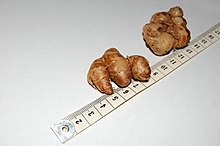
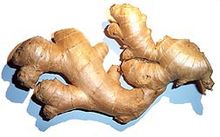

use
The Zingiberaceae family has a large number of species from 47 genera with medicinal potential. Some species are used as a spice, especially in Asian kitchens, especially the rhizomes. Few types are eaten as a vegetable or salad. Several types provide raw materials for the perfume industry. Varieties of many species are used as ornamental plants.
- Some genera with food, medicinal and aromatic plant species:
-
Aframomum :
- Grains of Paradise ( Aframomum melegueta )
-
Alpinia :
- Thai ginger ( Alpinia galanga )
-
Amomum :
- Black cardamom ( Amomum subulatum )
- Amomum testaceum Ridl.
-
Boesenbergia :
- Chinese ginger or fingerwort ( Boesenbergia rotunda )
-
Caulokaempferia :
- Caulokaempferia coenobialis (Hance) K.Larsen : Used in Chinese medicine.
-
Cautleya :
- Cautleya spicata (JMSm.) Bak. : The stem is eaten as a vegetable. Medical effects were examined.
-
Turmeric :
- Turmeric ( Curcuma longa L. )
- Javanese turmeric ( Curcuma xanthorrhiza Roxb. ): The drug (Curcumae xanthorrhizae rhizoma) is obtained from the rhizome.
- Lemon root ( Curcuma zedoaria Rosc. )
-
Elettaria :
- Green cardamom ( Elletaria cardamomum (L.) Maton )
-
Hedychium :
- Hedychium coronarium J.König : The budding and open flowers are eaten and used as a spice. The rhizome is eaten cooked. Medical effects were examined. Paper is made from cellulose. The essential oils are raw materials for the perfume industry. The fragrant flowers are with you in the evening.
- Hedychium gracile Roxb. : Parts of plants are used as a spice.
- Hedychium spicatum Buch.-Ham. : The fruit is eaten cooked. Medical effects were examined. The essential oils are raw materials for the perfume industry. The dried rhizome is used for smoking.
-
Kaempferia :
- Indian spice lily ( Kaempferia galanga )
-
Steel giant :
- Stahlianthus involucratus (King ex Baker) Craib ex Loes. : It is used in Chinese medicine.
-
Zingiber :
- Ginger ( Zingiber officinale Rosc. )
- Zingiber purpureum Rosc. : It is used in Chinese medicine.
- Mussel ginger ( Zingiber zerumbet )
-
Aframomum :
- In the genera Alpinia , Cornukaempferia , Curcuma , Etlingera , Globba , Hedychium , Renealmia and Zingiber there are some species whose varieties are ornamental plants for tropical parks and gardens. Varieties of a few species are used in the temperate latitudes as large potted or container plants for rooms or winter gardens .
swell
- The family of Zingiberaceae in APWebsite . (Sections systematics and description)
- The Zingiberaceae family at DELTA by L. Watson and MJDallwitz. (Section description)
- Delin Wu, Kai Larsen: Zingiberaceae. , Pp. 322–377 - the same text online as the printed work , In: Wu Zheng-yi, Peter H. Raven (ed.): Flora of China. Volume 24: Flagellariaceae through Marantaceae , Science Press and Missouri Botanical Garden Press, Beijing and St. Louis, 2000. ISBN 0-915279-83-5 (section description)
- Alan T. Whittemore: Zingiberaceae. - Same text online as the printed work , In: Flora of North America Editorial Committee (Ed.): Flora of North America North of Mexico. Volume 22: Magnoliophyta: Alismatidae, Arecidae, Commelinidae (in part), and Zingiberidae , Oxford University Press, New York and Oxford, 2000. ISBN 0-19-513729-9 (section description)
- Current family system, presented in a symposium .
- The Zingiberaceae family at the Smithsonian Institution's National Museum of Natural History (NMNH) .
- W. John Kress, Linda M. Prince, Kyle J. Williams: The phylogeny and a new classification of the gingers (Zingiberaceae): evidence from molecular data. In: American Journal of Botany , Volume 89, 2002, pp. 1682-1696: Online.
- Dhivya Selvaraj, Rajeev Kumar Sarma, Ramalingam Sathishkuma Phylogenetic analysis of chloroplast matK gene from Zingiberaceae for plant DNA barcoding. , In: Bioinformation , Volume 3, Issue 1, 2008, pp. 24–27, PMC 2586133 (free full text)
- W. John Kress, MF Newman, Axel Dalberg Poulsen & C. Specht: An analysis of generic circumscription in tribe Alpinieae (Alpinioideae: Zingiberaceae). In: Gardens' Bulletin Singapore , Volume 59, 2007, pp. 113-128.
Individual evidence
- ↑ a b c d e f g h i j k l m n Delin Wu, Kai Larsen: In: Wu Zheng-yi, Peter H. Raven (Ed.): Flora of China. Volume 24: Flagellariaceae through Marantaceae , Science Press and Missouri Botanical Garden Press, Beijing and St. Louis, 2000, ISBN 0-915279-83-5 . Zingiberaceae. , Pp. 322–377 - the same text online as the printed work.
- ^ Alan T. Whittemore: In: Flora of North America Editorial Committee (Ed.): Flora of North America North of Mexico. Volume 22: Magnoliophyta: Alismatidae, Arecidae, Commelinidae (in part), and Zingiberidae , Oxford University Press, New York and Oxford, 2000, ISBN 0-19-513729-9 . Zingiberaceae. - same text online as the printed work.
- ↑ a b The family of Zingiberaceae at DELTA by L. Watson and MJDallwitz.
- ↑ a b Robert Hegnauer: Chemotaxonomy of plants: an overview of the distribution and the systematic importance of plant substances. , Volume 7, 1986, pp. 780-794, ISBN 978-3-7643-0723-3 . Zingiberaceae on pp. 780–794 in Google Book Search
- ↑ a b W. John Kress, Linda M. Prince, Kyle J. Williams: The phylogeny and a new classification of the gingers (Zingiberaceae): evidence from molecular data. , In: American Journal of Botany , Volume 89, 2002, pp. 1682-1696: Online.
- ↑ a b Zingiberaceae at Tropicos.org. Missouri Botanical Garden, St. Louis, accessed November 12, 2014.
- ^ A b c Zingiberaceae on the Germplasm Resources Information Network (GRIN), USDA , ARS , National Genetic Resources Program. National Germplasm Resources Laboratory, Beltsville, Maryland.
- ↑ a b Dhivya Selvaraj, Rajeev Kumar Sarma & Ramalingam Sathishkuma Phylogenetic analysis of chloroplast matK gene from Zingiberaceae for plant DNA barcoding. In: Bioinformation , Volume 3, Issue, 2008, pp. 24–27, PMC 2586133 (free full text)
- ↑ a b Kyle J. Williams et al .: The Phylogeny, Evolution, and Classification of the Genus Globba and Tribe Globbeae (Zingiberaceae): Appendages Do Matter. , In: American Journal of Botany , Volume 91, Issue 1, 2004, pp. 100-114.
- ↑ a b c d e f g h i j k l m n o p q r s t u v w x y z aa ab ac ad ae af ag ah ai aj ak al am an ao Rafaël Govaerts, 1995: World Checklist of Seed Plants 1 (1, 2) , 1-483, 1-529. MIM, Deurne. Rafaël Govaerts (Ed.): Zingiberaceae. In: World Checklist of Selected Plant Families (WCSP) - The Board of Trustees of the Royal Botanic Gardens, Kew . Retrieved June 9, 2020.
- ↑ Kai Larsen & Thaya Jenjittikul: Laosanthus, a new genus of Zingiberaceae from Laos , in Nordic Journal of Botany , Volume 21, Issue 2, 2001, pp 135-138.
- ^ RJ Searle: The genus Scaphochlamys (Zingiberaceae - Zingibereae): a compendium for the field worker. In: Edinburgh Journal of Botany , Volume 67, 2010, pp. 75-121.
- ^ W. John Kress, Thet Htun: A Second Species of Smithatris (Zingiberaceae) from Myanmar. In: Novon , Volume 13, Issue 1, 2003, pp. 68-71.
- ↑ a b c d e f g h i Hugo de Boer, Mark Newman, Axel D. Poulsen, AJ Droop, Tomas Fér, Lê TT Hiên, Kristyna Hlavatá, Vichith Lamxay, James-Edward Richardson, Karin Steffen, Jana Leong-Škorničková : Convergent morphology in Alpinieae (Zingiberaceae): Recircumscribing Amomum as a monophyletic genus. In: Taxon , Volume 67, Issue 1, March 2018, pp. 6–36. doi : 10.12705 / 671.2
- ^ V. Lamxay, MF Newman: A revision of Amomum (Zingiberaceae) in Cambodia, Laos and Vietnam. In: Edinburgh Journal of Botany , Volume 69, 2012, pp. 99-206.
- ^ A b Axel D. Poulsen, Helena Båserud Mathisen, Mark Newman, Marlina Ardiyani, Øystein Lofthus, Charlotte Bjora: Sulettaria: A new ginger genus disjunct from Elettaria cardamomum. Taxon , Volume 67, August 2018, pp. 725-738. doi : 10.12705 / 674.3
- ^ Axel Dalberg Poulsen: Etlingera of Borneo , in Natural History Publications (Borneo). Kota Kinabalu, Sabah , 2006. ISBN 983-812-117-7 .
- ^ Kai Larsen: A new species of Caulokaempferia (Zingiberaceae) from Laos. , In: Edinburgh Journal of Botany , Volume 60, Issue 3, 2003, pp. 509-512.
- ↑ P. Suksathan: A new species of Caulokaempferia (Zingiberaceae) from Thailand. In: Edinburgh Journal of Botany , Volume 60, Issue 3, 2003, pp. 513-516.
- ↑ Chayan Picheansoonthon, Supachai Koonterm: Three New Species of the Yellow-flowered Caulokaempferia (Zingiberaceae) from Northeastern Thailand. , In: Taiwania , Volume 53, Issue 3, 2008, pp. 248-257: Online. ( Page no longer available , search in web archives ) Info: The link was automatically marked as defective. Please check the link according to the instructions and then remove this notice.
- ^ Cautleya spicata in Plants For A Future
- ↑ Entries on Hedychium in Plants For A Future
- ↑ Gordon Cheers (Ed.): Botanica: The ABC of plants. 10,000 species in text and images . Könemann Verlagsgesellschaft, 2003, ISBN 3-8331-1600-5 .
Web links
- Zingiberaceae Resource Center .
- Don Herbison-Evans, Christine Ashe: Zingiberaceae in Australia .
